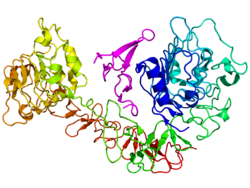Drug target
The identification of EGFR as an oncogene has led to the development of anticancer therapeutics directed against EGFR (called "EGFR inhibitors", EGFRi), including gefitinib, [28] erlotinib, [29] afatinib, brigatinib and icotinib [30] [31] for lung cancer, and cetuximab for colon cancer. More recently AstraZeneca has developed Osimertinib, a third generation tyrosine kinase inhibitor. [32] [31]
Many therapeutic approaches are aimed at the EGFR. Cetuximab and panitumumab are examples of monoclonal antibody inhibitors. However, the former is of the IgG1 type, the latter of the IgG2 type; consequences on antibody-dependent cellular cytotoxicity can be quite different. [33] Other monoclonals in clinical development are zalutumumab, nimotuzumab, and matuzumab. The monoclonal antibodies block the extracellular ligand-binding domain. With the binding site blocked, signal molecules can no longer attach there and activate the tyrosine kinase.
Another method is using small molecules to inhibit the EGFR tyrosine kinase, which is on the cytoplasmic side of the receptor. Without kinase activity, EGFR is unable to activate itself, which is a prerequisite for the binding of downstream adaptor proteins. Ostensibly, by halting the signaling cascade in cells that rely on this pathway for growth, tumor proliferation and migration are diminished. Gefitinib, erlotinib, brigatinib and lapatinib (mixed EGFR and ERBB2 inhibitor) are examples of small molecule kinase inhibitors.
CimaVax-EGF, an active vaccine targeting EGF as the major ligand of EGF, uses a different approach, raising antibodies against EGF itself, thereby denying EGFR-dependent cancers of a proliferative stimulus; [34] it is in use as a cancer therapy against non-small-cell lung carcinoma (the most common form of lung cancer) in Cuba, and is undergoing further trials for possible licensing in Japan, Europe, and the United States. [35]
There are several quantitative methods available that use protein phosphorylation detection to identify EGFR family inhibitors. [36]
New drugs such as osimertinib, gefitinib, erlotinib and brigatinib directly target the EGFR. Patients have been divided into EGFR-positive and EGFR-negative, based upon whether a tissue test shows a mutation. EGFR-positive patients have shown a 60% response rate, which exceeds the response rate for conventional chemotherapy. [37]
However, many patients develop resistance. Two primary sources of resistance are the T790M mutation and MET oncogene. [37] However, as of 2010, there was no consensus of an accepted approach to combat resistance nor FDA approval of a specific combination. Clinical trial phase II results reported for brigatinib targeting the T790M mutation, and brigatinib received Breakthrough Therapy designation status by the FDA in February 2015.
The most common adverse effect of EGFR inhibitors, found in more than 90% of patients, is a papulopustular rash that spreads across the face and torso; the rash's presence is correlated with the drug's antitumor effect. [38] In 10% to 15% of patients, the effects can be serious and require treatment. [39] [40]
Some tests are aiming at predicting benefit from EGFR treatment, as Veristrat. [41]
Laboratory research using genetically engineered stem cells to target EGFR in mice was reported in 2014 to show promise. [42] EGFR is a well-established target for monoclonal antibodies and specific tyrosine kinase inhibitors. [43]
































